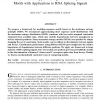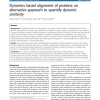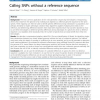447 search results - page 25 / 90 » Performance Analysis of Sequence Alignment Applications |
RECOMB
2003
Springer
14 years 9 months ago
2003
Springer
We propose a framework for modeling sequence motifs based on the maximum entropy principle (MEP). We recommend approximating short sequence motif distributions with the maximum en...
BMCBI
2010
13 years 4 months ago
2010
Background: The dynamic motions of many proteins are central to their function. It therefore follows that the dynamic requirements of a protein are evolutionary constrained. In or...
BMCBI
2011
13 years 4 months ago
2011
Background: Genomic position (GP) files currently used in next-generation sequencing (NGS) studies are always difficult to manipulate due to their huge size and the lack of approp...
SC
2009
ACM
14 years 1 months ago
2009
ACM
Executing large number of independent tasks or tasks that perform minimal inter-task communication in parallel is a common requirement in many domains. In this paper, we present o...
BMCBI
2010
13 years 9 months ago
2010
Background: The most common application for the next-generation sequencing technologies is resequencing, where short reads from the genome of an individual are aligned to a refere...



